It seems that there is no person in the world who would not admire this picture. You may not consider yourself a connoisseur of art or a connoisseur of beauty, but one glance at Botticelli's "Spring" is enough, as the soul is filled with joy and inspiration. Its creator managed to comprehend the very essence of the Renaissance, the time when beauty was admired and the creative impulses of artists were highly valued. "Spring" is not only one of the most beautiful, but also one of the most mysterious paintings in the entire history of fine art. At first glance, we have a holiday in honor of the arrival of spring. But is it? What are these wonderful characters talking about? What messages are encrypted in their gestures and looks? What do these flowers and fruits symbolize? To answer these questions, we will go on an exciting journey through Florence in the 15th century, in which amazing events took place at that time ...
Renaissance, Florence, Medici - three words, inextricably linked. In the 15th century, it reached unprecedented prosperity. Florence was the richest, most populous and beautiful city not only in Italy, but also in Europe. In 1469, the 20-year-old Lorenzo became the heir to the Medici family. He, nicknamed the Magnificent, will dispose of untold wealth and rule the city for almost 25 years. This time will be the Golden Age for Florence.
So, Lorenzo de' Medici is the ruler and inspirer of the city. He was idolized, he was imitated and everyone fell in love with him without exception. He and his younger brother Giuliano were real idols for contemporaries. Lorenzo - banker, philanthropist, poet, philosopher; Giuliano is a knight, a brilliant cavalier and courtier. They gathered a brilliant society around them: Lorenzo preferred to surround himself with the most prominent people of his time, Giuliano with beautiful ladies.
In the Palazzo Medici and in the villa in Careggi, music was always playing, poetry was heard, philosophical conversations were held, in which Lorenzo, Giuliano and the most prominent representatives of their time took part: the philosopher Marsilio Ficino, the humanist Picodella Mirandola, the poet Angelo Poliziano, artists and sculptors: Perugino (future teacher of Raphael), Ghirlandaio (future teacher of Michelangelo), Andrea Verrocchio (teacher of Leonardo), Sandro Botticelli ... They called themselves members of the "Platonic Academy" - a free society of people who loved ancient culture. The "Neoplatonists" were looking for a new truth, creating a universal religious system that combined the wisdom of Plato and Christian dogmas. They believed that human power was almost like divine power. The great divine work, crowned with the creation of man, is repeated by man himself, who thinks and creates.
And, of course, this gave rise to a special art. Subtle, aristocratic, true to the ideals of antiquity, filled with symbols, musical and poetic. A striking example: the painting by Perugino (Raphael's teacher) "Apollo and Marsyas" and the sculpture by Antonio del Pollaiolo "Hercules and Antaeus", which adorned Giuliano's room. Architects, sculptors and artists created stunning masterpieces commissioned by the Medici. At that time, only Lorenzo the Magnificent could be the inspirer of creators for such masterpieces, spend fabulous money on this. This brought him fame, power and even greater power.
The most receptive and subtle artist at the court of Lorenzo was the young Florentine Sandro Botticelli. He loved his patron very much, but was even more attached to his friend, Giuliano de' Medici. It was the chivalrous service of a friend to his beautiful lady, Simonetta Vespucci, that inspired the artist.
Florence in the seventies of the XV century is an endless series of celebrations. City holidays, masses, trips, carnivals succeeded each other without stopping. A special place in the life of Florence was occupied by jousting tournaments. The tournament was both a training before the war, and an opportunity to show one's prowess, and a place to demonstrate luxury (they dressed up for a tournament like a ball), which is forbidden on ordinary days.
In 1475, a young beauty was also present at one of these tournaments in Santa Croce Square, and Giuliano Medici, a participant in the tournament, dedicating his victory to her, carried a standard made according to Botticelli's drawings, depicting Athena, who had a portrait resemblance to Simonetta. Florentines were bewitched by this story, the whole city began to consider Simonetta their queen. And for this she had everything: she was a beautiful, noble and married woman ... and she died young (at 23 from tuberculosis). The city mourned its queen, and Giuliano was inconsolable.
On April 26, 1478, Florence again plunged into mourning: as a result of the Pazzi conspiracy, Giuliano Medici was brutally murdered. This event forever changed Lorenzo: he became sad and no longer thought about life as an eternal holiday. And, of course, the death of Simonetta and Giuliano shocked Sandro Botticelli. He decides to devote his whole life to this sublime love.
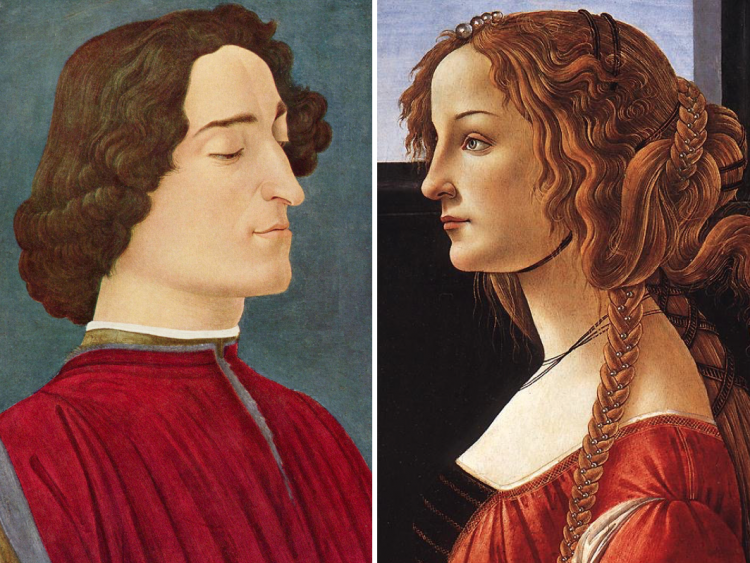
Around 1478, Botticelli creates the painting "Spring", unthinkable and incredible. After all, this is not a portrait, not an icon, a religious plot, but a new secular art, a fantasy born of the artist's ardent imagination. In the orange garden, mythological characters represent an allegory of the coming of spring: Zephyr, the god of the east wind, pursues the nymph Chloris, who, after her wedding with Zephyr, who overtook her, turns into Flora, the goddess of spring. In the center of the picture is Venus, the goddess of love and a soaring Cupid. On the left are the three Graces and Mercury, with a caduceus wand that drives away the clouds.
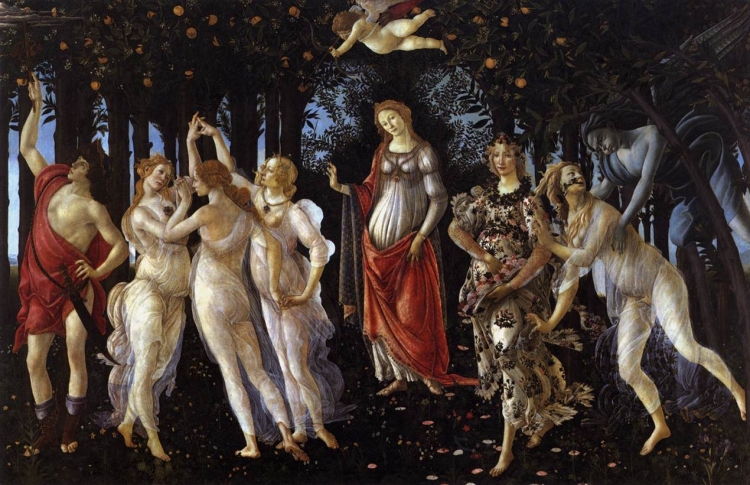
With a greater degree of probability, it can be argued that it was Lorenzo the Magnificent who ordered the painting. After all, the allegory presented, based on the traditions of antiquity, dreamy, sad, idealized beautiful - just the kind of art that Lorenzo and the members of the Platonic Academy highly appreciated.
It is all the more surprising that according to the documents, both "Spring" and "The Birth of Venus" were listed for another Medici, Lorenzo il Popolano. And the masterpieces of Botticelli belonged to his villa in Castello (near Florence). However, all the decorations of the three Graces from the picture are images of real-life jewels from the collection of Lorenzo the Magnificent.
Experts agree that both "Spring" and "The Birth of Venus" were Lorenzo's wedding gift to his cousin.

It is this assumption of historians and art historians that allows for the option that we are facing a wedding celebration. And if this is a wedding, then Mercury is the groom, and Flora is the bride. In addition, there is Venus, the goddess of love, and Cupid, and the dancing Graces. Blossoming orange trees are a symbol of marriage and childbearing. Take a closer look, all the women look pregnant, and the male characters frame the picture, as if representing an allegory of life itself.
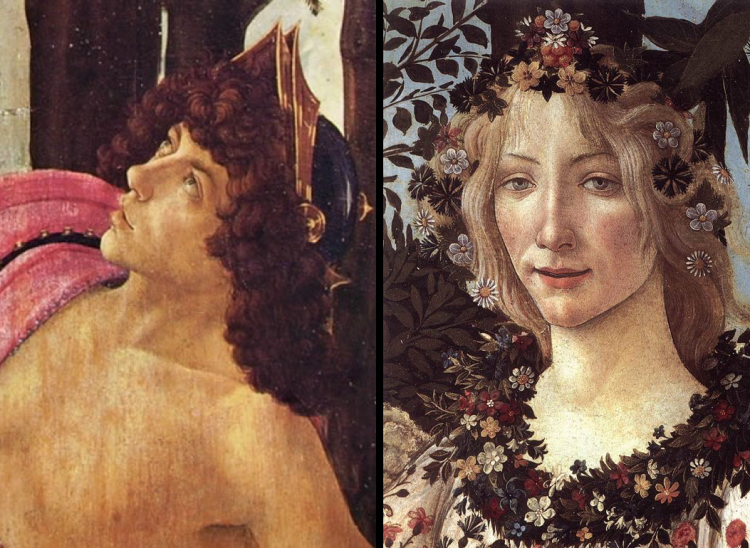
There is another version of reading "Spring", and it is devoid of joy. Both Giuliano and Simonetta died in the spring. If this is a sad memory, then "Spring" immediately takes on a gloomy tone. None of the characters cast a shadow or touch the ground with their feet. And Zephyr no longer looks like a breeze that brings spring. He is the breath of death that takes the young Giuliano and the beautiful Simonetta.

There is another interpretation of Botticelli's "Spring". Perhaps this is a calendar of agricultural work. It sounds rather strange, but such illustrations of the seasons were quite common in those days. Note that orange trees only bloom above the head of Flora, representing April.
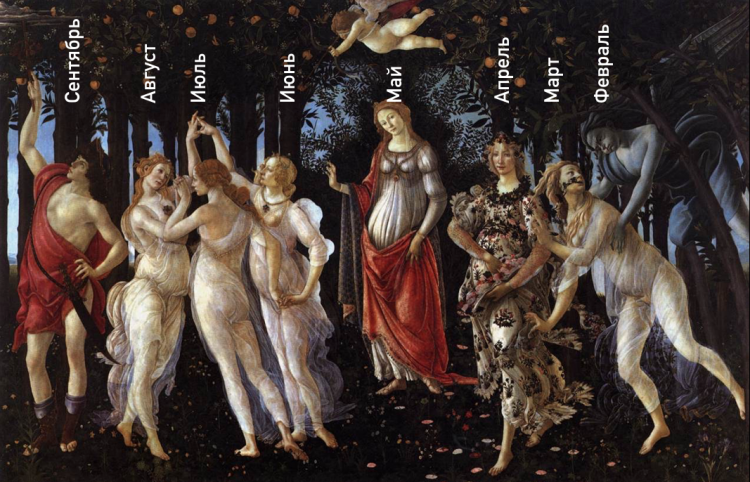
The latest restoration, during which pollution was removed from the painting, made it possible to see "Spring" almost in its original form. The meadow, previously darkened, shone with renewed colors. Scientists have identified more than five hundred real-life plants! It should be noted that Sandro Botticelli was fascinated by a botanist, he painted leaves, flowers and fruits with extraordinary diligence, besides, Greek books about plants that the artist could study were kept in Lorenzo's library.

It is also possible that "Spring" is an allegory of Florence, a city that flourished under the rule of the Medici, love and harmony reign here. In this case, the image of the iris at the feet of Flora, the heraldic symbol of the city, acquires a special meaning. The garden is also symbolic, because the orange tree is the symbol of Lorenzo the Magnificent. The ruler of the city himself is allegorically depicted in the form of Mercury, a peacemaker and negotiator, driving the clouds away from Florence. Just at this time, Lorenzo de' Medici participated in establishing peace between Rome and Naples.
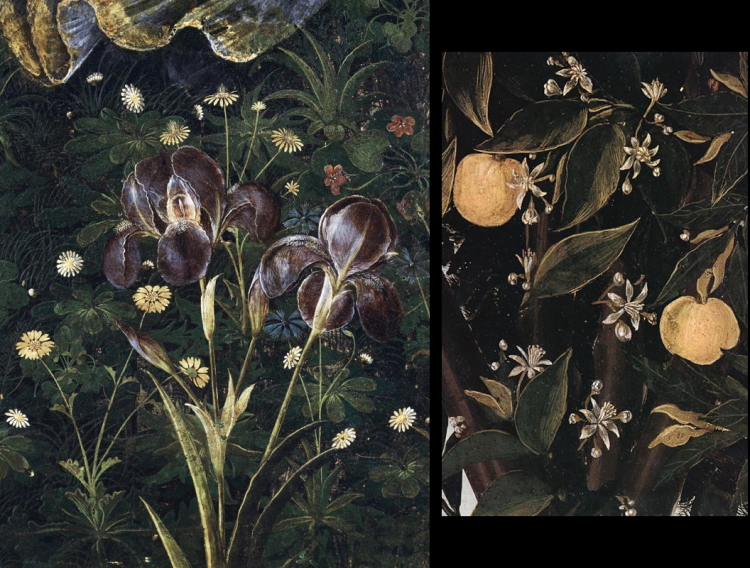
An important key to understanding "Spring" is ancient literature. Probably, the picture was created as an illustration to a fragment of Lucretius's poem "On the Nature of Things":
Here comes Spring, and Venus is coming, and Venus is winged
The messenger is coming ahead, and, Zephyr after, before them
Flora-mother walks and, scattering flowers on the way,
It fills everything with colors and a sweet smell ...
Winds, goddess, run before you; with your approach
The clouds are leaving from heaven, the earth is a masterful lush
A flower carpet is being laid, sea waves are smiling,
And the azure sky shines with spilled light
And to an excerpt from Ovid's poem "Fasta":
“I am called Flora, and I was Chlorida ...
One spring, Zephyr caught my eye; I left
He flew after me: he was stronger than me ...
Nevertheless, Zephyr justified violence, making me his wife,
And I never complain about my marriage union.
Eternal I bask in the spring, spring is the best time:
All the trees are green, the earth is green.
A fertile garden blooms in the fields, to me as a dowry of data ...
My husband adorned my garden with a beautiful flower dress,
So saying to me: “Forever be the goddess of flowers!”
But to count all the colors on flowers scattered everywhere,
I never could: there is no number to their number ...
They follow Harita, weaving wreaths and garlands,
To twist your curls and braids into heaven
But no matter how many interpretations and options for reading this masterpiece exist, its main riddle cannot be solved for five centuries now ... how could a person create such divine beauty?
- In contact with 0
- Google+ 0
- OK 0
- Facebook 0








